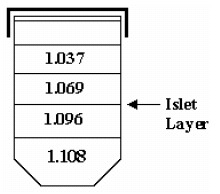Protocol
Collagenase Preparation
- Weigh out the collagenase into a 50 ml conical and add isolation buffer to make the final concentration, as indicated in the table below. Dissolve the collagenase by vortexing.(12 mice + 2 extra mice = 14 mice x 5 ml/mouse = 70 ml total collagenase solution)(70 ml x 0.5 mg/ml or 0.3 mg/ml = 35 mg or 21 mg of collagenase P total)
StrainAgeCollagenase P (mg/ml)Time (min) C3H, Balb/C, B6 > 12 weeks 0.8 17 C3H, Balb/C, B6 <= 12 weeks 0.5 13 NOD, NOR, NON > 12 weeks 0.8 17 NOD, NOR, NON <= 12 weeks 0.5 17 Dispense 2 ml of collagenase solution into each glass vial and place on ice. Load each 5 ml syringe with 3 ml of collagenase add 30g needle and place in ice (prepare in hood).
Distension
Just before dissection, sacrifice animal by cervical dislocation. Spray the whole body with 70% of ETOH, making it completely wet. Make a V-insision starting at the genital area. Rotate the mouse so the tail is facing away from you.
Remove the bowel to the left side of the open mouse. This will expose the pancreas and common bile duct.
Place a hemostat clamp on either side of the small-intestinal, where the bile duct drains, leaving a small pocket for collagenase solution to enter the intestine.
Inflate the pancreas through the bile duct with a 30g needle and 5 ml syringe containing 3 ml of cold collagenase solution, starting at the gall bladder.
Remove the pancreas from the body and place it in a siliconized vial containing 2 ml of collagenase solution. This step should be done QUICKLY and as cleanly as possible, minimizing collection of fat and connective tissue.
Place the vial on ice and repeat step 3 with the next mouse.
Digestion
Seal each vial and place it into a 37°C water-bath. Incubate for 13-17 minutes (time varies with strain and age of the animal).
After time has elapsed, shake the vial vigorously. The pancreas should fall apart.
Pour each digest through a large sterile sink strainer into a sterile 1000 ml beaker and forcefully pipette off the screen with washing buffer. Dispense the digests into 50 ml conicals tubes (3 pancreata/50 ml tube: if n=12, use enough washing buffer to make the final volume 200 ml and dispense it to 4x50 ml tubes). The dilution should be done rapidly and on ice to avoid unwanted islet digestion.
Spin down: Start the centrifuge. When it reaches 1300 rpm, turn it off.
Aspirate the supernatant, leaving ~5 mL. Be very cautious not to aspirate the pellet.
Resuspend pellet by tapping vigorously with your hand, then add 50 ml of wash buffer.
Spin down: Start the centrifuge. When it reaches 1300 rpm, turn it off.
Resuspend the pellet and wash with 5 ml of washing buffer.
Transfer the 5 ml to 15 ml conical and spin down, as above.
Aspirate the supernatant as completely as possible. (Remaining buffer might cause the change of the density of the Ficoll.)
Ficoll
Perform quickly. Long-term Ficoll exposure is TOXIC to islets.
Make sure pellet is completely broken up prior to adding ficoll (unbroken tissue is difficult to resuspend in ficoll).
Resuspend the pellet in 7 ml of ficoll, density 1.108, by vortexing vigorously.
Layer on top of each density of ficoll 2ml of each of the remaining densities in this order: 1.096, 1.069, then 1.037.
Spin for 15 minutes at 1800 rpm at 4 degrees, with break OFF!
Pick islets from the second layer using spoid (sterile plastic eyedropper). Transfer all collections to a 50 ml conical containing ~25 mL of cold buffer.
Wash, as above, 3 times with washing buffer (repeating step 12-15).
Resuspend Islets in 20 ml RPMI-1640 (containing 10% FCS and penicillin and streptomycin, HEPES, MEM-NEAA) and mix gently. Remove 100 ul of sample for counting.
Transfer 100 ul to 35 mm Grid-plate containing 1 ml of media and 1 ml dithizone.
Incubate remaining islets in RPMI 1640, in a 37°C, 7% CO2 incubator, in 160 mm plates with a total of 30 ml of media/plate.



